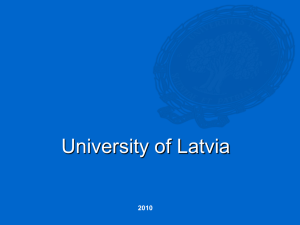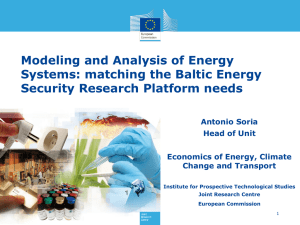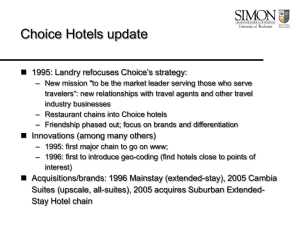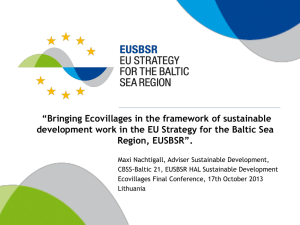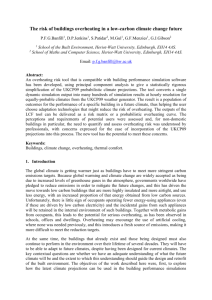STRUCTURALLY BALANCED ECONOMIC GROWTH MODEL FOR
advertisement
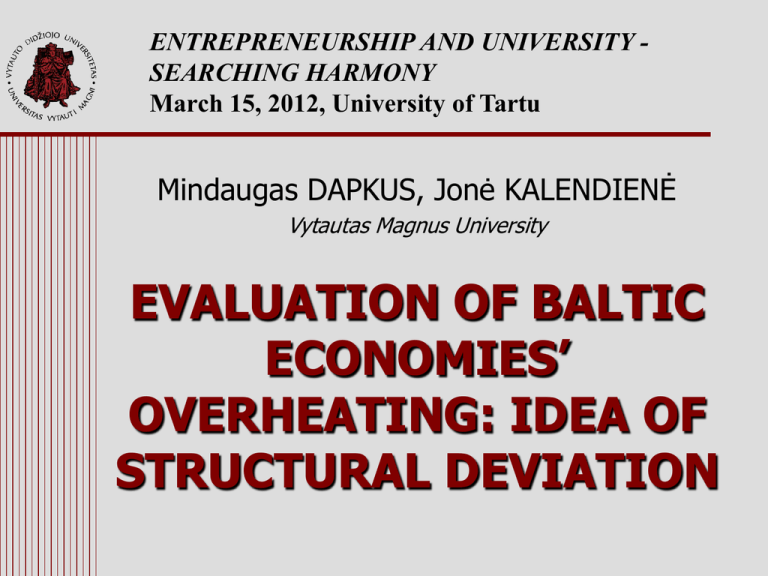
ENTREPRENEURSHIP AND UNIVERSITY SEARCHING HARMONY March 15, 2012, University of Tartu Mindaugas DAPKUS, Jonė KALENDIENĖ Vytautas Magnus University EVALUATION OF BALTIC ECONOMIES’ OVERHEATING: IDEA OF STRUCTURAL DEVIATION Overheating term • Overheating of an economy occurs when its productive capacity is unable to keep pace with growing aggregate demand. • In this paper: overheating there are imbalances between supply and demand, capital and labor and it is followed by transformations of production structure (structural disbalances) Introduction • Question: how to evaluate the risk of economy overheating? • Level of exploration: – Deviation of some indicators related with overheating (inflation, current account, unemployment,…) – GDP Deviation from potential product (HP, Kalman filtr) • Problem: there is no reliable method which could help to estimate the fact and the moment of economy overheating. Structural Convergence and overheating evaluation idea 100% A sector SA Actual economy structure in developing country SB SC 100% 0 SD*A SA* B sector SB* SD*B C sector SC* SD*C t* T Benchmark : structure of developed economies Time, t Estimation steps: methodology 1. Estimation of structural benchmark of developed economies (1995-1998) 2. Calculation of average deviation of developed economies structure (Denmark, Austria, Finland and Norway) 3. Evaluation of initial Structural situation for Baltic States (1995-1998) 4. Evaluation of the sustainable development benchmark of Baltic States economies during 1999 – 2010 5. Calculation of the Overheating index for Baltic States Evaluation of initial Structural situation for Baltic States and aspirations 35.00 Baltic States economies' structure 1995-1998 30.00 25.00 A-B 20.00 C-E % F 15.00 G-I J-K 10.00 L-P 5.00 0.00 Lithuania Latvia Estonia Developed Estimation of risk-free structural deviation (RF) on the basis of developed States 1 m SD i SDiC m C 1 * 1 T SDiC SDiCt T t 1 RFiCt SDiCt SDi* RF 9,17 The sustainable development benchmark of Baltic States economies 1999 – 2010 * SD i S i 0 ki TK S Si 0 ki * t * it 1.20 1.00 Planed intensity of structural change in Baltic States sectors 0.80 Lithuania 0.60 Latvia Estonia 0.40 0.20 0.00 -0.20 -0.40 -0.60 A-B C-E F G-I J-K L-P Structural adaptation level n * S S it it RF i 1 RF Structural Economy Overheating Index (SOHI) Dynamics of Baltic States Overheating index in 300.00 1999-2010 250.00 200.00 Estonia Latvia Lithuania % 150.00 100.00 50.00 0.00 -50.00 2010 2009 2008 2007 2006 2005 2004 2003 2002 2001 2000 1999 -100.00 Internal structure deviations: Lithuania 8.00 Lithuania's absolut structural deviations from benchmark during 1999-2010 6.00 A-B 4.00 C-E 2.00 0.00 1998 -2.00 -4.00 -6.00 F G-I 2000 2002 2004 2006 2008 2010 J-K 2012 L-P Internal structure deviations: Latvia Latvia's absolut structural deviations from benchmark during 1999-2010 8.00 6.00 4.00 2.00 0.00 1999 2000 2001 2002 2003 2004 2005 2006 2007 2008 2009 2010 -2.00 -4.00 A-B C-E F G-I J-K L-P -6.00 -8.00 Internal structure deviations: Estonia Estonia's absolut structural deviations from benchmark during 1999-2010 6.00 4.00 2.00 0.00 1999 2000 2001 2002 2003 2004 2005 2006 2007 2008 2009 2010 -2.00 -4.00 A-B C-E F G-I J-K L-P -6.00 The future…? 40.00 Baltic States economies' structure in 2010 35.00 30.00 A-B 25.00 C-E 20.00 F 15.00 G-I 10.00 J-K 5.00 L-P 0.00 Lithuania Latvia Estonia Developed 20042007 ENTREPRENEURSHIP AND UNIVERSITY SEARCHING HARMONY March 15, 2012, University of Tartu Mindaugas DAPKUS, Jonė KALENDIENĖ Vytautas Magnus University EVALUATION OF BALTIC ECONOMIES’ OVERHEATING: IDEA OF STRUCTURAL DEVIATION
